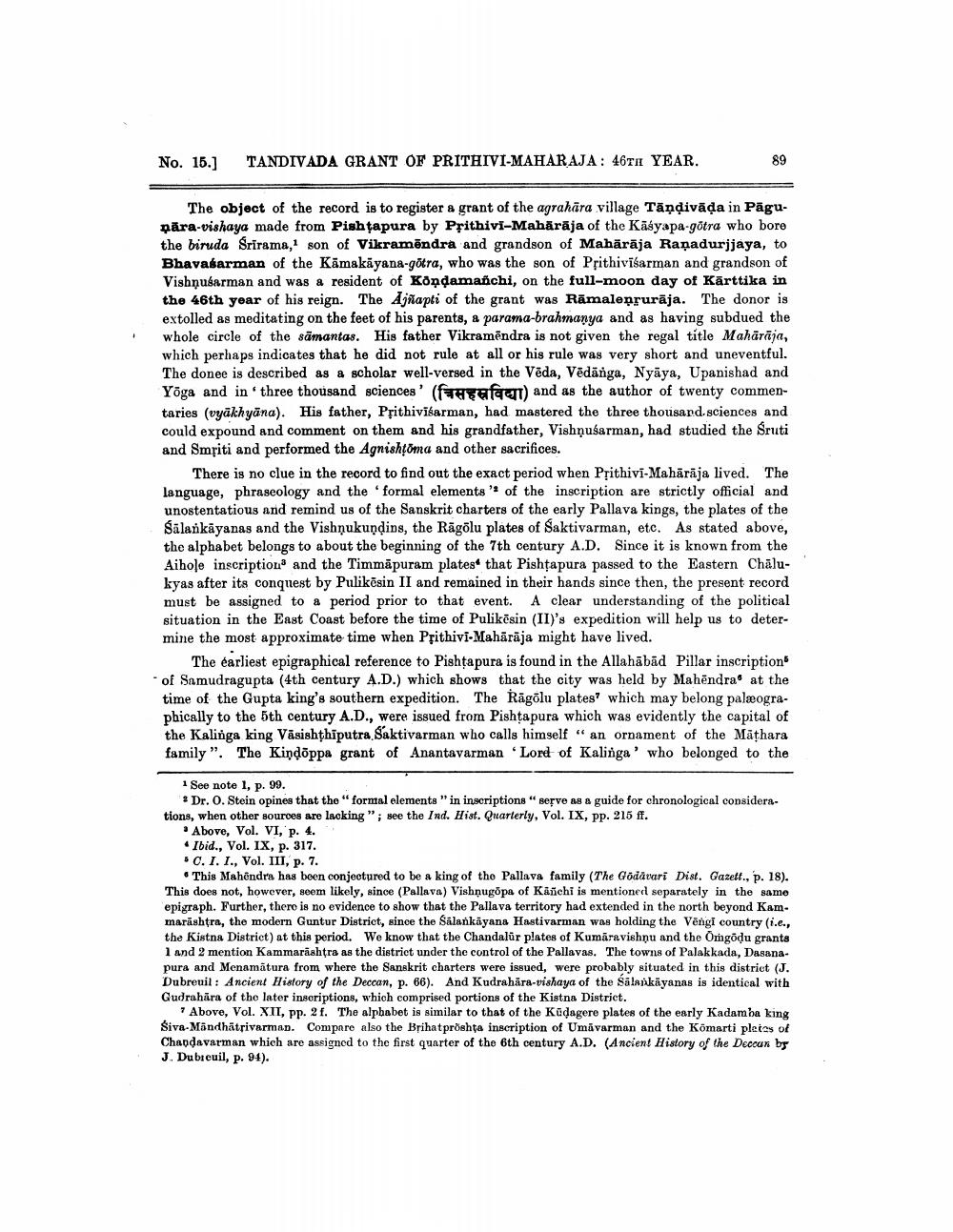________________
No. 15.)
TANDIVADA GRANT OF PRITHIVI-MAHARAJA: 46TH YEAR.
The object of the record is to register a grant of the agrahāra village Tāņçivāda in Pāgupāra-vishaya made from Pishtapura by Prithivi-Mahārāja of the Kāsyapa-gotra who bore the biruda Srirama, son of Vikramēndra and grandson of Mahārāja Raņadurjjaya, to Bhavatarman of the Kāmakāyana-gotra, who was the son of Přithivīšarman and grandson of Vishņusarman and was a resident of Kondamañchi, on the full-moon day of Kārttika in the 46th year of his reign. The Ajñapti of the grant was Rāmaleprurāja. The donor is extolled as meditating on the feet of his parents, a parama-brahmanya and as having subdued the whole circle of the sāmantas. His father Vikramēndra is not given the regal title Mahārāja, which perhaps indicates that he did not rule at all or his rule was very short and uneventful. The donee is described as a scholar well-versed in the Vēda, Vēdānga, Nyāya, Upanishad and Yoga and in three thousand sciences' (TH C ) and as the author of twenty commentaries (vyākhyāna). His father, Pțithivīšarman, had mastered the three thousand.sciences and could expound and comment on them and his grandfather, Vishņusarman, had studied the Sruti and Smriti and performed the Agnishtoma and other sacrifices.
There is no clue in the record to find out the exact period when Prithivi-Mahārāja lived. The language, phraseology and the formal elements of the inscription are strictly official and unostentatious and remind us of the Sanskrit charters of the early Pallava kings, the plates of the Śálarkāyanas and the Vishnukundins, the Rāgõlu plates of Saktivarman, etc. As stated above, the alphabet belongs to about the beginning of the 7th century A.D. Since it is known from the Aihole inscriptions and the Timmāpuram plates that Pishtapura passed to the Eastern Chālukyas after its conquest by Pulikēsin II and remained in their hands since then, the present record must be assigned to a period prior to that event. A clear understanding of the political situation in the East Coast before the time of Pulikēsin (II)'s expedition will help us to determine the most approximate time when Pțithivi-Mahārāja might have lived.
The earliest epigraphical reference to Pishta pura is found in the Allahābād Pillar inscriptions of Samudragupta (4th century A.D.) which shows that the city was held by Mahēndra at the time of the Gupta king's southern expedition. The Rāgālu plates? which may belong palæographically to the 5th century A.D., were issued from Pishtapura which was evidently the capital of the Kalinga king Vāsishthiputra Saktivarman who calls himself "an ornament of the Māthara family". The Kindõppa grant of Anantavarman 'Lord of Kalinga' who belonged to the
1 See note 1, p. 99.
Dr. O. Stein opines that the "formal elements "in inscriptions "serve as a guide for chronological considerations, when other sources are lacking"; see the Ind. Hist. Quarterly, Vol. IX, pp. 215 ff.
. Above, Vol. VI, p. 4. • Ibid., Vol. IX, p. 317. 50. I. I., Vol. III, p. 7.
• This Mahendra has been conjectured to be a king of the Pallava family (The Godavari Dist. Gazett., p. 18). This does not, however, seem likely, since (Pallava) Vishņugopa of Kanchi is mentioned separately in the same epigraph. Further, there is no evidence to show that the Pallava territory had extended in the north beyond Kammarashtra, the modern Guntur District, since the Salankāyana Hastivarman was holding the Vengi country (i..., the Kistna District) at this period. We know that the Chandalur plates of Kumāravishnu and the Orgödu grants 1 and 2 mention Kammarāshtra as the district under the control of the Pallavas. The towns of Palakkada, Dasanapura and Menamātura from where the Sanskrit charters were issued, were probably situated in this district (J. Dubreuil : Ancient History of the Deccan, p. 66). And Kudrahăra-vishaya of the Salankāyanas is identical with Gudrahāra of the later inscriptions, which comprised portions of the Kistna District.
* Above, Vol. XII, pp. 21. The alphabet is similar to that of the Kodagere plates of the early Kadamba king Siva-Mändhätrivarman. Compnre also the Brihatproshta inscription of Umavarman and the Kömarti pletas of Chapdavarman which are assigned to the first quarter of the 6th century A.D. (Ancient History of the Decoux by J. Dubreuil, p. 94).




